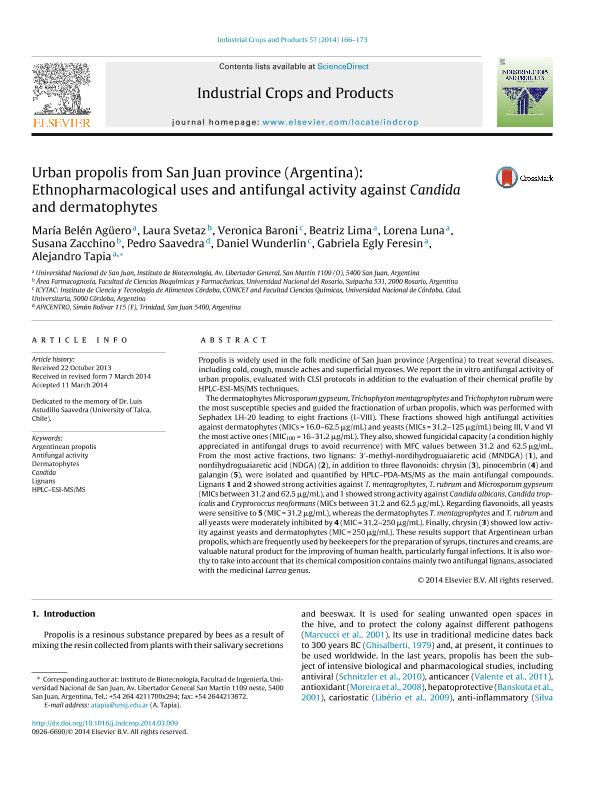Artículo
Urban propolis from San Juan province (Argentina): Ethnopharmacological uses and antifungal activity against Candida and dermatophytes
Aguero, María Belen; Svetaz, Laura Andrea ; Baroni, María Verónica
; Baroni, María Verónica ; Lima, Beatriz Viviana
; Lima, Beatriz Viviana ; Luna, Lorena Celina
; Luna, Lorena Celina ; Zacchino, Susana Alicia Stella; Saavedra, Pedro; Wunderlin, Daniel Alberto
; Zacchino, Susana Alicia Stella; Saavedra, Pedro; Wunderlin, Daniel Alberto ; Feresin, Gabriela Egly
; Feresin, Gabriela Egly ; Tapia, Aníbal Alejandro
; Tapia, Aníbal Alejandro
 ; Baroni, María Verónica
; Baroni, María Verónica ; Lima, Beatriz Viviana
; Lima, Beatriz Viviana ; Luna, Lorena Celina
; Luna, Lorena Celina ; Zacchino, Susana Alicia Stella; Saavedra, Pedro; Wunderlin, Daniel Alberto
; Zacchino, Susana Alicia Stella; Saavedra, Pedro; Wunderlin, Daniel Alberto ; Feresin, Gabriela Egly
; Feresin, Gabriela Egly ; Tapia, Aníbal Alejandro
; Tapia, Aníbal Alejandro
Fecha de publicación:
03/2014
Editorial:
Elsevier Science
Revista:
Industrial Crops and Products
ISSN:
0926-6690
Idioma:
Inglés
Tipo de recurso:
Artículo publicado
Clasificación temática:
Resumen
Propolis is widely used in the folk medicine of San Juan province (Argentina) to treat several diseases, including cold, cough, muscle aches and superficial mycoses. We report the in vitro antifungal activity of urban propolis, evaluated with CLSI protocols in addition to the evaluation of their chemical profile by HPLC-ESI-MS/MS techniques. The dermatophytes Microsporum gypseum, Trichophyton mentagrophytes and Trichophyton rubrum were the most susceptible species and guided the fractionation of urban propolis, which was performed with Sephadex LH-20 leading to eight fractions (I–VIII). These fractions showed high antifungal activities against dermatophytes (MICs = 16.0–62.5 μg/mL) and yeasts (MICs = 31.2–125 μg/mL) being III, V and VI the most active ones (MIC100 = 16–31.2 μg/mL). They also, showed fungicidal capacity (a condition highly appreciated in antifungal drugs to avoid recurrence) with MFC values between 31.2 and 62.5 μg/mL. From the most active fractions, two lignans: 3′-methyl-nordihydroguaiaretic acid (MNDGA) (1), and nordihydroguaiaretic acid (NDGA) (2), in addition to three flavonoids: chrysin (3), pinocembrin (4) and galangin (5), were isolated and quantified by HPLC–PDA-MS/MS as the main antifungal compounds. Lignans 1 and 2 showed strong activities against T. mentagrophytes, T. rubrum and Microsporum gypseum (MICs between 31.2 and 62.5 μg/mL), and 1 showed strong activity against Candida albicans, Candida tropicalis and Cryptococcus neoformans (MICs between 31.2 and 62.5 μg/mL). Regarding flavonoids, all yeasts were sensitive to 5 (MIC = 31.2 μg/mL), whereas the dermatophytes T. mentagrophytes and T. rubrum and all yeasts were moderately inhibited by 4 (MIC = 31.2–250 μg/mL). Finally, chrysin (3) showed low activity against yeasts and dermatophytes (MIC = 250 μg/mL). These results support that Argentinean urban propolis, which are frequently used by beekeepers for the preparation of syrups, tinctures and creams, are valuable natural product for the improving of human health, particularly fungal infections. It is also worthy to take into account that its chemical composition contains mainly two antifungal lignans, associated with the medicinal Larrea genus
Archivos asociados
Licencia
Identificadores
Colecciones
Articulos(CCT - ROSARIO)
Articulos de CTRO.CIENTIFICO TECNOL.CONICET - ROSARIO
Articulos de CTRO.CIENTIFICO TECNOL.CONICET - ROSARIO
Articulos(CEFOBI)
Articulos de CENTRO DE EST.FOTOSINTETICOS Y BIOQUIMICOS (I)
Articulos de CENTRO DE EST.FOTOSINTETICOS Y BIOQUIMICOS (I)
Articulos(ICYTAC)
Articulos de INST. DE CIENCIA Y TECNOLOGIA DE ALIMENTOS CORDOBA
Articulos de INST. DE CIENCIA Y TECNOLOGIA DE ALIMENTOS CORDOBA
Articulos(SEDE CENTRAL)
Articulos de SEDE CENTRAL
Articulos de SEDE CENTRAL
Citación
Aguero, María Belen; Svetaz, Laura Andrea; Baroni, María Verónica; Lima, Beatriz Viviana; Luna, Lorena Celina; et al.; Urban propolis from San Juan province (Argentina): Ethnopharmacological uses and antifungal activity against Candida and dermatophytes; Elsevier Science; Industrial Crops and Products; 57; 3-2014; 166-173
Compartir
Altmétricas



